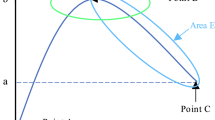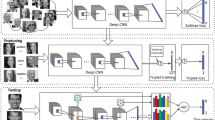Abstract
Face recognition plays a critical role in surveillance and security systems. Due to the large appearance variation of human faces, the dissimilarity among faces for the same person may be quite large. This leads to unstable results. To improve the stability and reliability of face recognition, this paper proposes a novel deep-based approach by introducing an adaptively-weighted verification loss function. The proposed loss function can properly enlarge the margin between positive face pairs and negative face pairs from the global perspective, thus obtain a more reliable recognition model by minimizing the dissimilarity between same-person faces and maximizing the dissimilarity between different-person faces. Experiments on the benchmark LFW and YTF datasets demonstrate that the proposed approach can obtain the state-of-the-art performances for face recognition.
Access this chapter
Tax calculation will be finalised at checkout
Purchases are for personal use only
Similar content being viewed by others
References
Sun, Y., Chen, Y., Wang, X., et al.: Deep learning face representation by joint identification-verification. In: Advances in Neural Information Processing Systems, pp. 1988–1996 (2014)
Taigman, Y., Yang, M., Ranzato, M.A., et al.: Deepface: closing the gap to human-level performance in face verification. In: Proceedings of the IEEE Conference on Computer Vision and Pattern Recognition, pp. 1701–1708 (2014)
Huang, G.B., Ramesh, M., Berg, T., et al.: Labeled faces in the wild: a database for studying face recognition in unconstrained environments. Technical Report 07–49, University of Massachusetts, Amherst (2007)
Jia, Y., Shelhamer, E., Donahue, J., et al.: Caffe: convolutional architecture for fast feature embedding. In: Proceedings of the 22nd ACM International Conference on Multimedia, pp. 675–678. ACM (2014)
Parkhi, O.M., Vedaldi, A., Zisserman, A.: Deep face recognition. In: BMVC, vol. 1(3), p. 6 (2015)
Schroff, F., Kalenichenko, D., Philbin, J.: Facenet: a unified embedding for face recognition and clustering. In: Proceedings of the IEEE Conference on Computer Vision and Pattern Recognition, pp. 815–823 (2015)
Yi, D., Lei, Z., Liao, S., et al.: Learning face representation from scratch. arXiv preprint arXiv:1411.7923 (2014)
Turk, M.A., Pentland, A.P.: Face recognition using eigenfaces. In: IEEE Computer Society Conference on Computer Vision and Pattern Recognition, 1991, Proceedings CVPR 1991, pp. 586–591. IEEE (1991)
Chen, D., Cao, X., Wen, F., et al.: Blessing of dimensionality: high-dimensional feature and its efficient compression for face verification. In: Proceedings of the IEEE Conference on Computer Vision and Pattern Recognition, pp. 3025–3032 (2013)
Chen, D., Cao, X., Wang, L., Wen, F., Sun, J.: Bayesian face revisited: a joint formulation. In: Fitzgibbon, A., Lazebnik, S., Perona, P., Sato, Y., Schmid, C. (eds.) ECCV 2012. LNCS, vol. 7574, pp. 566–579. Springer, Heidelberg (2012). https://doi.org/10.1007/978-3-642-33712-3_41
Huang, G.B., Learned-Miller, E.: Labeled faces in the wild: Updates and new reporting procedures. Dept. Comput. Sci., Univ. Massachusetts Amherst, Amherst, MA, USA, Technical report, 14–003 (2014)
Felzenszwalb, P.F., Girshick, R.B., McAllester, D., et al.: Object detection with discriminatively trained part-based models. IEEE Trans. Patt. Anal. Mach. Intell. 32(9), 1627–1645 (2010)
Xiong, X., De la Torre, F.: Supervised descent method and its applications to face alignment. In: Proceedings of the IEEE Conference on Computer Vision and Pattern Recognition, pp. 532–539 (2013)
Wen, Y., Zhang, K., Li, Z., Qiao, Y.: A discriminative feature learning approach for deep face recognition. In: Leibe, B., Matas, J., Sebe, N., Welling, M. (eds.) ECCV 2016. LNCS, vol. 9911, pp. 499–515. Springer, Cham (2016). https://doi.org/10.1007/978-3-319-46478-7_31
Cao, X., Wipf, D., Wen, F., et al.: A practical transfer learning algorithm for face verification. In: Proceedings of the IEEE International Conference on Computer Vision, pp. 3208–3215 (2013)
Sun, Y., Liang, D., Wang, X., et al.: Deepid3: face recognition with very deep neural networks. arXiv preprint arXiv:1502.00873 (2015)
Wolf, L., Hassner, T., Maoz, I.: Face recognition in unconstrained videos with matched background similarity. In: CVPR, pp. 529–534 (2011)
Masi, I., Tr\(\grave{\hat{{\rm a}}}\)n, A.T., Hassner, T., Leksut, J.T., Medioni, G.: Do We Really Need to Collect Millions of Faces for Effective Face Recognition? In: Leibe, B., Matas, J., Sebe, N., Welling, M. (eds.) ECCV 2016. LNCS, vol. 9909, pp. 579–596. Springer, Cham (2016). https://doi.org/10.1007/978-3-319-46454-1_35
Hu, G., Peng, X., Yang, Y., et al.: Frankenstein: learning deep face representations using small data. arXiv preprint arXiv:1603.06470 (2016)
Acknowledgement
This work is supported by Tencent Research Grant, National Science Foundation of China (61471235, 61720106001), and Shanghai “The Belt and Road” Young Scholar Exchange Grant (17510740100).
Author information
Authors and Affiliations
Corresponding author
Editor information
Editors and Affiliations
Rights and permissions
Copyright information
© 2018 Springer Nature Singapore Pte Ltd.
About this paper
Cite this paper
Qiu, F., Lin, W., Liu, X., Yu, H., Xiong, H. (2018). Deep Face Recognition Using Adaptively-Weighted Verification Loss Function. In: Zhai, G., Zhou, J., Yang, X. (eds) Digital TV and Wireless Multimedia Communication. IFTC 2017. Communications in Computer and Information Science, vol 815. Springer, Singapore. https://doi.org/10.1007/978-981-10-8108-8_17
Download citation
DOI: https://doi.org/10.1007/978-981-10-8108-8_17
Published:
Publisher Name: Springer, Singapore
Print ISBN: 978-981-10-8107-1
Online ISBN: 978-981-10-8108-8
eBook Packages: Computer ScienceComputer Science (R0)




